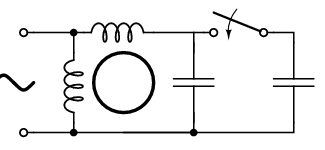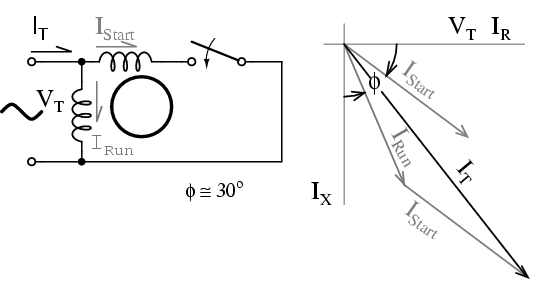Capacitor-run Motor Induction Motor
Capacitor-run motor induction motor: A variation of the capacitor-start motor (Figure below) is to start the motor with a relatively large capacitor for high starting torque, but leave a smaller value capacitor in place after starting to improve running characteristics while not drawing excessive current. The additional complexity of the capacitor-run motor is justified for larger size motors.

Capacitor-run motor induction motor.
A motor starting capacitor may be a double-anode non-polar electrolytic capacitor which could be two to (or - to -) series connected polarized electrolytic capacitors. Such AC rated electrolytic capacitors have such high losses that they can only be used for intermittent duty (1 second on, 60 seconds off) like motor starting. A capacitor for motor running must not be of electrolytic construction, but a lower loss polymer type.
Resistance split-phase motor induction motor: If an auxiliary winding of much fewer turns of smaller wire is placed at 90o electrical to the main winding, it can start a single phase induction motor. (Figure below) With lower inductance and higher resistance, the current will experience less phase shift than the main winding. About 30o of phase difference may be obtained. This coil produces a moderate starting torque, which is disconnected by a centrifugal switch at 3/4 of synchronous speed. This simple (no capacitor) arrangement serves well for motors up to 1/3 horsepower (250 watts) driving easily started loads.

Resistance split-phase motor induction motor.
This motor has more starting torque than a shaded pole motor (next section), but not as much as a two phase motor built from the same parts. The current density in the auxiliary winding is so high during starting that the consequent rapid temperature rise precludes frequent restarting or slow starting loads.
Single-phase induction motors
- Single-phase induction motors are not self-starting without an auxiliary stator winding driven by an out of phase current of near 90o. Once started the auxiliary winding is optional.
- The auxiliary winding of a permanent-split capacitor motor has a capacitor in series with it during starting and running.
- A capacitor-start induction motoronly has a capacitor in series with the auxiliary winding during starting.
- A capacitor-run motor typically has a large non-polarized electrolytic capacitor in series with the auxiliary winding for starting, then a smaller non-electrolytic capacitor during running.
- The auxiliary winding of a resistance split-phase motor develops a phase difference versus the main winding during starting by virtue of the difference in resistance.